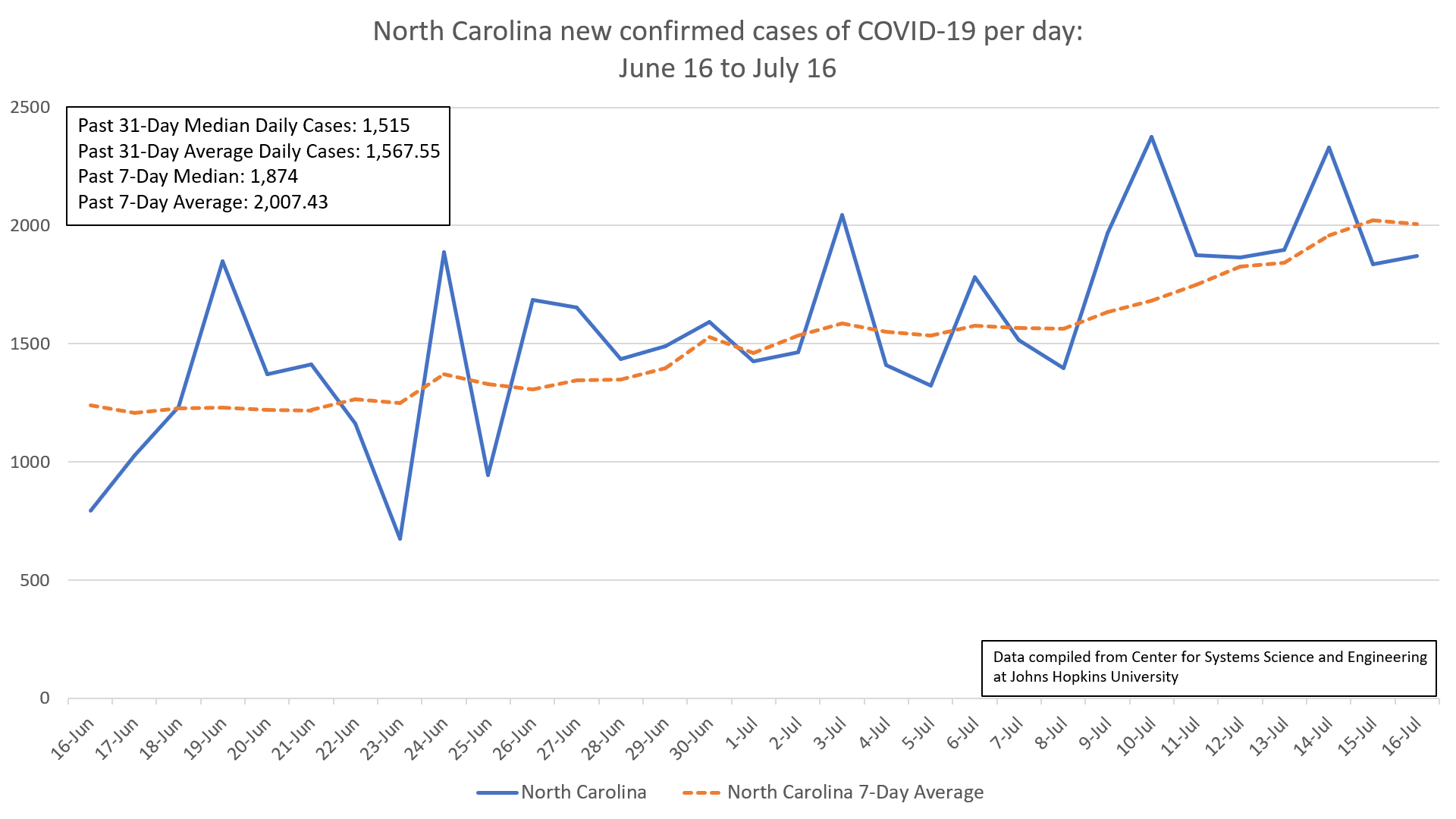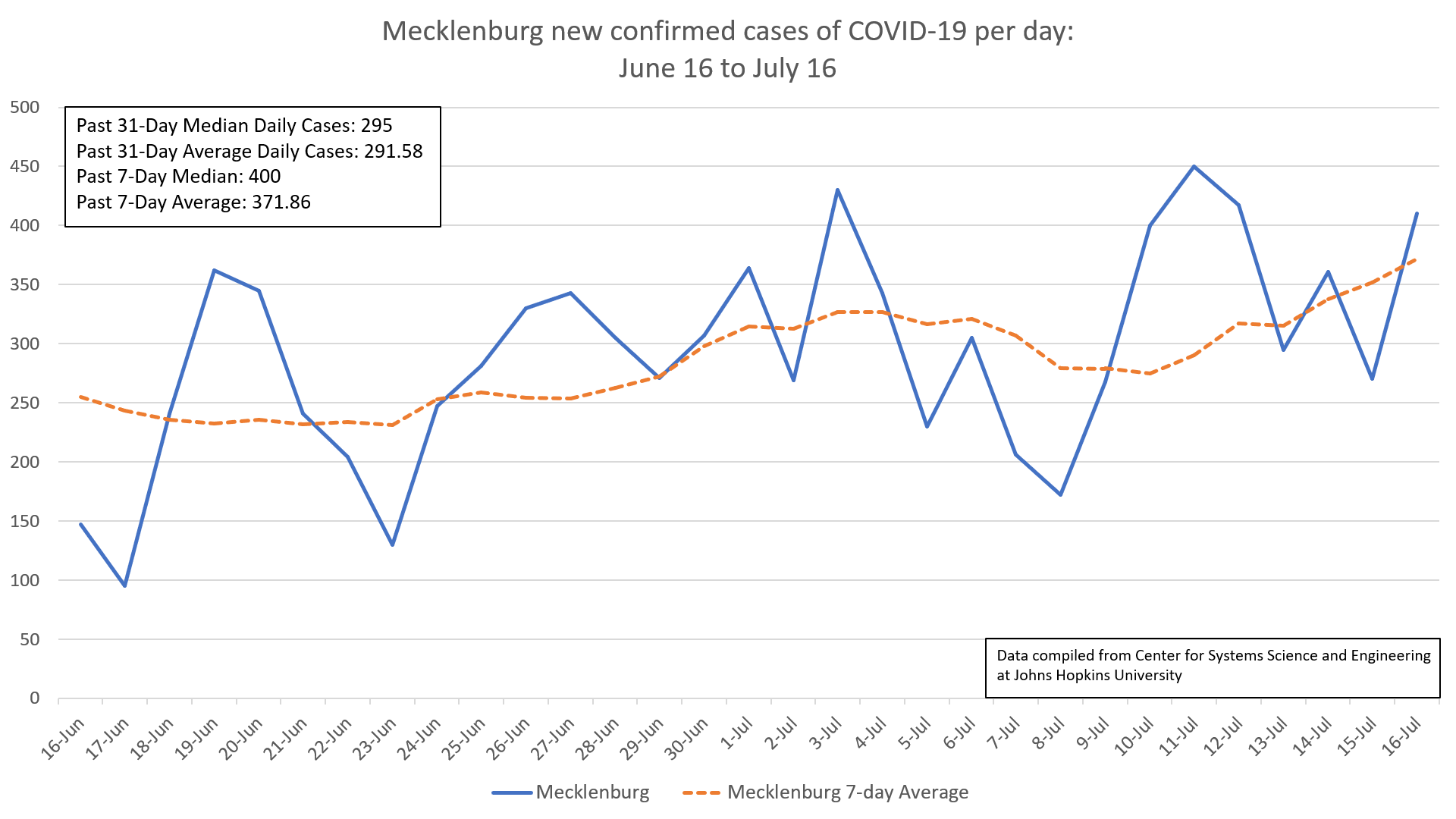
Using Johns Hopkins data, we compiled a chart of new confirmed cases of COVID-19 per day in NC from June 16 through July 16. Our average number of new daily cases since June 16 is 1,568 and its median is 1,515. The past 7-day average and median are higher at 2,007 and 1,874.
July 17. By Dave Yochum. Some 95,477 people in North Carolina have tested positive for the coronavirus and 1,606 have died, according to the NC Dept. of Health & Human Services. The increase in positive cases—2,051 from yesterday—is down from yesterday’s increase of 2,160 cases.
At the rate we’re going, North Carolina will break through the 100,000 cases milestone in a matter of two or three days.
On Saturday last week there were 2,462 new cases, but the upward trajectory has eased off since then.
Still, the state’s median number of new daily cases since June 16 is 1,515. The past seven-day median number of new daily cases is 23.7 percent higher, at 1,874, based on data from Johns Hopkins University.
Hospitalizations in North Carolina hit a new high: 1,180, up from 1,046 exactly a week ago and 846 one month ago.
Deaths are up as well: 1,608 in North Carolina since state officials began tracking the pandemic in March. It’s an increase of 18 since yesterday’s report and an increase of 127 in one week. Statewide, there have been more than 1.34 million tests, with roughly 8 percent coming back positive.
On a local level
In Mecklenburg, the epicenter of the coronavirus outbreak in North Carolina, tests are coming back positive at the rate of 11 percent, the NCDHHS data show.
The new report from NCDHHS says there are 297 new cases of COVID-19 in Mecklenburg, for a total of 16,657. A week ago, there were 14,157 Mecklenburg cases.
In Cornelius there are now 257 cases, up four from yesterday; in Davidson, 124, up one from yesterday; and in Huntersville, 398, up eight from yesterday.
Cornelius cases increased by 50 in a single week.
Mecklenburg County has had a 7-day running average accounting for approximately 18.7 percent of the state-wide cases per day, based on data from Johns Hopkins.
Children affected
On Tuesday, Gov. Roy Cooper directed schools to reopen in August with a mix of in-person instruction and remote learning. Districts are choosing the best course for their community.
Coronavirus infections are often milder in younger children. Because they have not been in school or other crowded settings, there have been fewer reported cases of children transmitting the virus.
But cases of anxiety and depression are spiking among young teens feeling the stress and uncertainty of the COVID-19 pandemic, said Charlene Wong, an associate professor of pediatrics at Duke School of Medicine.
“I’ve had patients describe it to me as being stuck in an anxiety attack and having a really hard time getting out of that,” Wong said this week during a remote media briefing to discuss reopening schools and the impact of COVID-19 on children.
NC vs. Sweden and Czechia
On an international level, the United States is setting records in the spread of the coronavirus. At noon today, Johns Hopkins was reporting 3.59 million cases of the coronavirus, and 138,649 deaths in the United States.
Johns Hopkins says Sweden, with about 10.2 million people, has had 77,281 cases and 5,619 deaths. Czechia (Czech Republic), with about 10.7 million people, has had 13,612 cases and 358 deaths.
Both Czechia and Sweden are roughly the same size as North Carolina (10.6 million people), which has had 95,477 cases of the coronavirus and 1,606 related deaths. We’re faring much better than Sweden but worse than Czechia.
Sweden is noteworthy for taking a more laissez-faire approach to the pandemic.
Sweden, unlike the rest of Scandinavia, was less rigorous around closing schools and businesses to fight the spread of the virus. The country has created a commission to evaluate its response to the novel coronavirus, reacting to criticism over a death toll that has exceeded its neighbors.
David Rubin, MD, director of PolicyLab at Children’s Hospital of Philadelphia and a professor of Pediatrics at the University of Pennsylvania’s Perelman School of Medicine, said the United States is inadvertently beginning to do another Sweden by relaxing around social distancing and face-masks.
“We’ve reached a point in communities throughout Arizona, Texas and Florida where the epidemic is accelerating at an alarming pace and may quickly overwhelm local health care systems—signaling a need to pause reopening plans,” Rubin said.
“For those other areas of rising concern in our model that have forecasts similar to those of Arizona just a few weeks ago, we would encourage local leaders to view our projections as an early warning system and enact swift response measures to prevent further widespread community transmission,” he said.
If you’d like us to compare the North Carolina COVID-19 data or the United States data to another country using Johns Hopkins data, let us know by emailing corneliustoday@gmail.com
Mecklenburg new cases: 1 week vs 1 month







